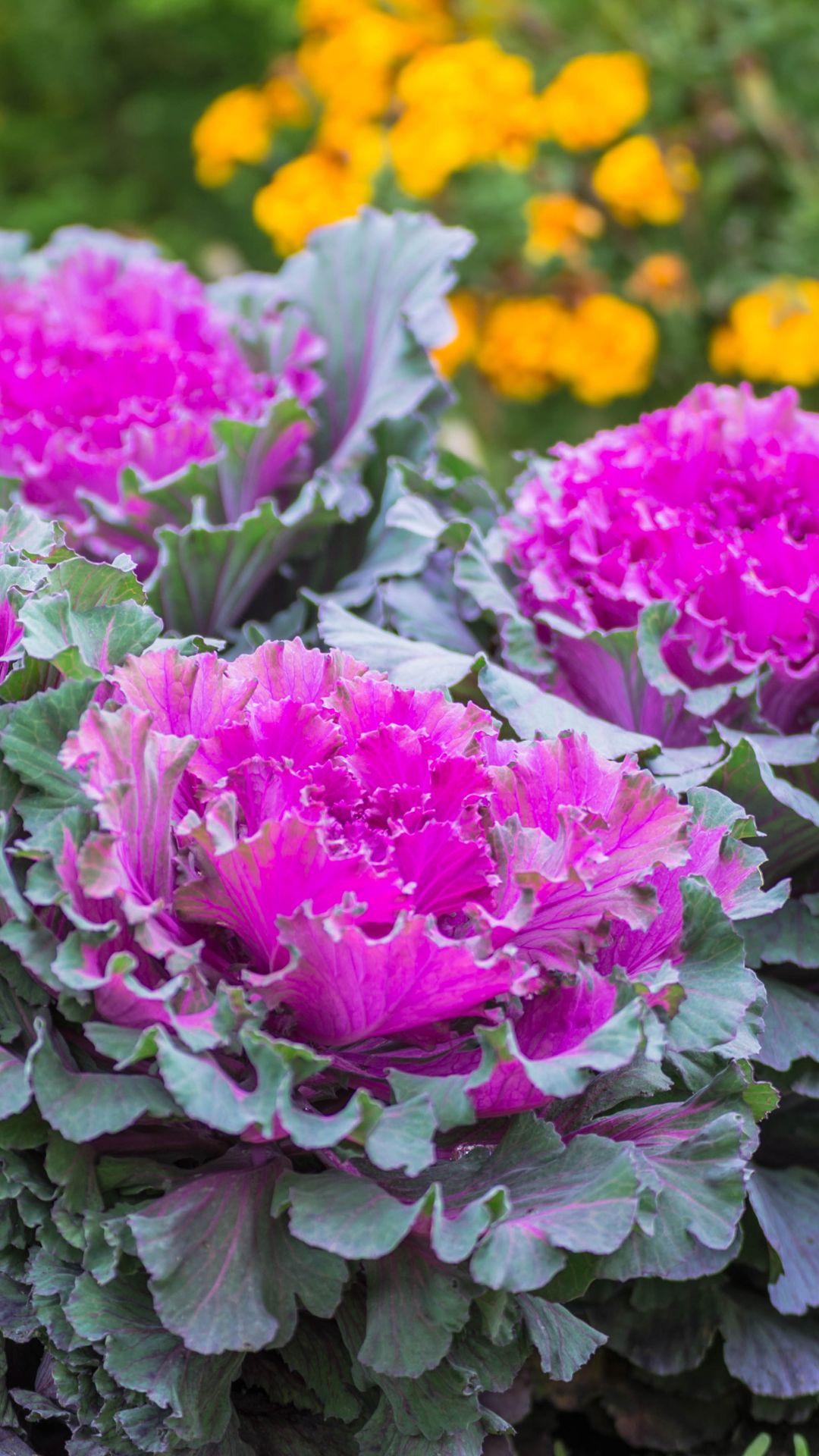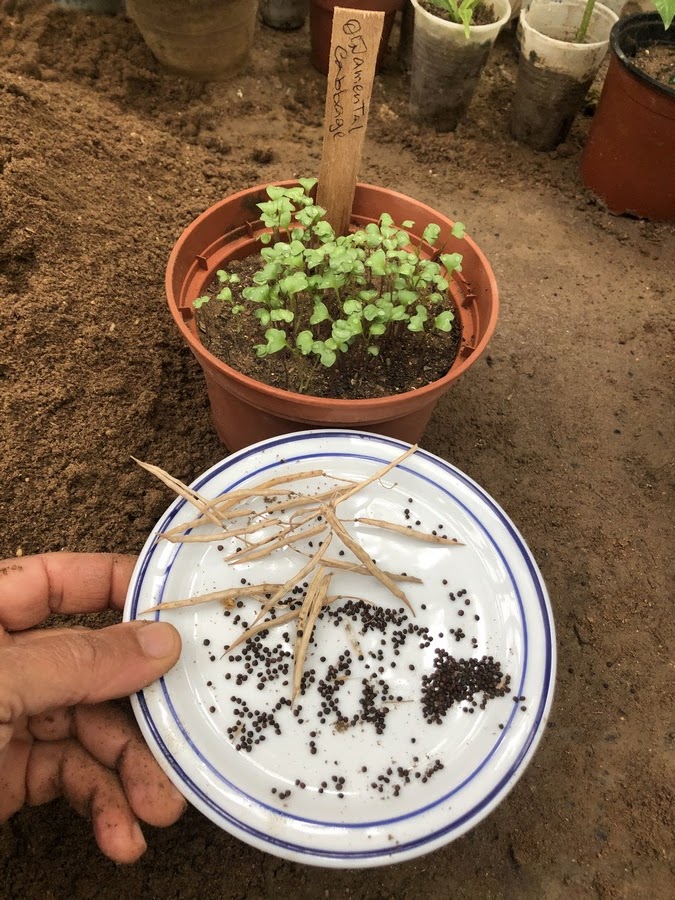Step into the enchanting world of fall with the exquisite hues of ornamental cabbage. As the temperatures cool, the Brassica oleracea family unveils its captivating cool-season annual, inviting you to cultivate a garden adorned with nature's kaleidoscope. Delve into the art of cultivating ornamental cabbage and kale, where the emphasis is on the visual symphony of colors rather than the culinary palate. This all-encompassing guide takes you on a journey, unraveling the secrets of growing and nurturing these botanical gems. Discover the steps to transform your garden into a vibrant tapestry of autumnal elegance, as we unlock the secrets to cultivating and caring for ornamental cabbage, ensuring a breathtaking spectacle in your fall sanctuary.
Ornamental cabbage and kale are biennials, which means they grow vegetative leaves in the first year and produce flowers and seeds in the second year of their life cycle. However, these plants are typically grown as annuals for their decorative foliage. Their leaves form rosettes of purple, rose, and creamy white colors, resembling large flowers rather than vegetables. Smooth leaf margins and broad, flat leaves are commonly referred to as flowering cabbages, while serrated or fringed leaf margins are considered flowering kales.
Plant Profile
- Common Name: Ornamental cabbage, ornamental kale
- Botanical Name: Brassica oleracea
- Family: Brassicaceae
- Plant Type: Annual or biennial
- Height – 12 to 16 inches (30 to 40 cm)
- Sun Exposure: Full sun
- Soil Type: Rich loam, well-draining
- Soil pH: Slightly acidic (5.5 to 6.5)
- Hardiness Zones: 2–11 (USDA)
- Foliage: evergreen
- Flowering: fall, spring
- Native Area: Western Europe, the Mediterranean, and temperate Asia
Growing Conditions for Ornamental Cabbage
Ornamental cabbage and kale are relatively easy to grow, but they do have specific preferences when it comes to growing conditions. By providing the right environment, you can ensure healthy growth and vibrant foliage.
Light Requirements
These plants thrive in full sun, but if you live in a warmer climate, partial afternoon shade is ideal. This helps protect the leaves from scorching in intense sunlight.
Ornamental cabbage and kale are relatively easy to grow, but they do have specific preferences when it comes to growing conditions. By providing the right environment, you can ensure healthy growth and vibrant foliage.
Light Requirements
These plants thrive in full sun, but if you live in a warmer climate, partial afternoon shade is ideal. This helps protect the leaves from scorching in intense sunlight.
Soil Needs
Ornamental cabbage and kale prefer an organically rich, loamy soil that drains well. Aim for a slightly acidic soil pH of about 5.5 to 6.5. If your soil is heavy and poorly drained, consider amending it with organic matter or planting in raised beds to improve drainage.
Watering
Keeping the plants well-watered is essential for their growth. They prefer soil that is consistently moist but not soggy. Ensure optimal soil moisture with a simple touch test – gauge the top inch of soil; if it feels dry, it's a signal to quench your plant's thirst. Strike a balance by avoiding overwatering, a potential culprit for root rot. Keep your green companions flourishing with the right hydration touchpoints.
If your area receives regular rainfall, you may not need to water them frequently. However, during dry spells, be prepared to provide supplemental watering to ensure they stay hydrated.
Temperature and Humidity
Ornamental cabbage and kale develop their vibrant colors when exposed to cool temperatures. They can withstand winter conditions, but their appearance greatly depends on the weather. When grown in hot climates with long daylight exposure, they may bolt and go to seed prematurely. Harsh storms and excessive rainfall can also cause damage to the leaves.
These plants can tolerate temperatures as low as 5 degrees Fahrenheit, but a sudden drop in temperature may harm or kill them. Humidity typically doesn't pose a significant issue for ornamental cabbage and kale, but in damp conditions with poor air circulation, they may be susceptible to fungal diseases.
Fertilization
Ornamental cabbage and kale only require fertilization at the time of planting. Use a balanced fertilizer to provide essential nutrients. Avoid fertilizing while they're actively growing, as it can lead to leggy growth and loss of color.
Choosing the Right Varieties
When it comes to ornamental cabbage and kale, there might not be a wide range of variety options available to home gardeners. Most seed packets are simply labeled "ornamental cabbage." However, you can focus on selecting color combinations that appeal to you.
Flowering kales can be divided into fringed-leaved cultivars (with ruffled leaves) and feather-leaved cultivars (with finely serrated leaves). Here are a few popular varieties to consider:
Chidori' ornamental kale: This variety features curly leaf edges and comes in purple, creamy white, or deep magenta.
Color Up' ornamental cabbage: With green leaves and centers of white, pink, or fuchsia, this variety grows upright.
Osaka' ornamental cabbage: Known for its large smooth leaves, this cabbage has center colors of pink, red, or white and maintains a compact size.
Peacock' ornamental kale: Resembling edible kale, this plant has deeply serrated leaves in red, purple, or white.
Pigeon' series ornamental cabbage: This variety has a flattened shape with red or white centers.
Propagation of Ornamental Cabbage and Kale
While ornamental cabbage and kale are typically discarded before their second year, you can collect seeds from faded flower heads and replant them. Propagation from seeds allows you to maintain your favorite varieties and expand your ornamental cabbage collection.
Watch How To Collect Ornamental Cabbage Seeds Video🌸🌿
For spring plants, start cabbage or kale seeds indoors about eight weeks before the last expected frost date. For fall display, start the seeds around July 1 and transplant the seedlings into the garden in mid-August.
Use small pots filled with a seed-starter mix to sow the seeds. Plant them about 1/4 inch deep and keep the soil moist.
Place the pots in a bright location with a temperature of around 70 degrees Fahrenheit.
The seedlings will emerge in 10 to 21 days. Once they reach a suitable size, transplant them outdoors after the last spring frost or in mid to late August for fall/winter display.
Caring for Ornamental Cabbage and Kale
Ornamental cabbage and kale require minimal care once they are established. However, there are a few key factors to keep in mind to ensure their healthy growth and stunning foliage.
Pest Control
Like their edible counterparts, ornamental cabbage and kale can be susceptible to various pests, including cabbage worms, cabbage loopers, flea beetles, caterpillars, thrips, slugs, and aphids. Regularly inspect the plants for any signs of infestation and take appropriate measures to control the pests.
Handpicking pests off the plants, using hard water sprays to dislodge them, or applying insecticidal soaps.
Disease Prevention
Ornamental cabbage and kale may encounter common disease problems, such as leaf spots, blackleg, black rot, and yellows. These diseases are more likely to occur in damp conditions. To prevent diseases, it is important to maintain good air circulation around the plants. Watering at the base of the plants and avoiding overhead watering can also help minimize the risk of fungal infections.
If disease symptoms appear, early intervention with appropriate fungicides may help control the spread.
Overwintering
Ornamental cabbage and kale are typically grown as cool-season annuals and are often discarded after their first season. However, many gardeners leave them in place well into winter because the rosettes of leaves remain attractive until repeated hard frosts cause them to wilt.
Container Gardening
If you prefer to grow ornamental cabbage and kale in containers, they can make beautiful seasonal potted plants. Choose a container with ample drainage holes and use an all-purpose potting mix.
Common Problems and Solutions
Ornamental cabbage and kale, though used primarily for ornamental purposes, are still susceptible to common vegetable diseases and pests.
Here are some notable Ornamental cabbage and kale problems you may encounter and their potential solutions:
- Leaf Punctures: Tiny chomping culprits like cabbage worms, caterpillars, slugs, and aphids may leave behind distinctive holes in your plant's leaves as they indulge in a feast. Use insecticidal soaps or chemical sprays to control these pests.
- Black or Yellow Spots on Leaves: Spots on leaves indicate fungal or bacterial infections, which are more likely in damp conditions. Good air circulation and fungicides applied early can help manage these diseases.
- Ugly Tall Stalks: If your cabbage or kale suddenly sends up a sparse and unattractive stalk, it is bolting (going to flower). The plant's ornamental value is diminished, but you can allow it to continue growing if you want to collect seeds for future planting.
Utilizing Ornamental Cabbage and kale in the Garden Landscape
Ornamental cabbage and kale can be used in various ways to enhance the beauty of your garden landscape. They look especially stunning when planted in large groupings or used as edging for garden beds. The purplish hues of their leaves blend well with other fall colors, making them great companions for chrysanthemums, asters, and ornamental grasses.
Consider incorporating ornamental cabbage and kale into window boxes, containers, or even mixed with other potted plants. Their unique foliage adds texture and interest to any display. Additionally, the plants can withstand winter conditions and continue to provide visual appeal when covered in a cloak of fresh snow.
Conclusion
Growing ornamental cabbage is a rewarding and straightforward endeavor. By providing the right growing conditions and following proper care practices, you can enjoy vibrant and colorful foliage throughout the fall season. Enhance the allure of your garden with ornamental cabbage and kale, versatile plants that effortlessly elevate any outdoor space, whether planted directly in the soil or in stylish containers. These botanical gems promise a harmonious blend of beauty and sophistication, transforming your garden landskape into a visual masterpiece. Embrace the cool weather and create a stunning fall display with these captivating plants.
Want to Grow Ornamental Cabbage!
Affiliate Disclosure
This blog post contains affiliate links to products on Amazon. This means that if you click on one of these links and make a purchase, we may earn a small commission. This commission comes at no additional cost to you but helps support the creation of valuable content for our readers.
The inclusion of affiliate links is a way for us to earn a modest compensation for the time and effort invested in researching, curating, and presenting information. It's important to note that the products recommended in this blog post are chosen based on their perceived value, relevance to the content, and positive reviews, not solely on the potential for earning commissions.
We want to assure our readers that our primary goal is to provide informative and unbiased content. The presence of affiliate links does not influence the editorial integrity of our recommendations. We only endorse products that we genuinely believe may bring value to our audience.
Please be aware that individual experiences with products may vary, and it's advisable to conduct personal research or consult customer reviews before making a purchase decision. Your support through the use of affiliate links is greatly appreciated and contributes to the sustainability of our efforts to provide quality content.
If you have any questions or concerns regarding the affiliate links in this blog post, feel free to reach out to us. We value transparency and aim to maintain the trust of our readers.



